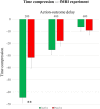How the effects of actions become our own
- PMID: 32937445
- PMCID: PMC7458439
- DOI: 10.1126/sciadv.aay8301
How the effects of actions become our own
Abstract
Every day, we do things that cause effects in the outside world with little doubt about who caused what. To some, this sense of agency derives from a post hoc reconstruction of a likely causal relationship between an event and our preceding movements; others propose that the sense of agency originates from prospective comparisons of motor programs and their effects. Using functional magnetic resonance imaging, we found that the sense of agency is associated with a brain network including the pre-supplementary motor area (SMA) and dorsal parietal cortex. Transcranial magnetic stimulation affected the sense of agency only when delivered over the pre-SMA and specifically when time-locked to action planning, rather than when the physical consequences of the actions appeared. These findings make a prospective theory of the sense of agency more likely.
Copyright © 2020 The Authors, some rights reserved; exclusive licensee American Association for the Advancement of Science. No claim to original U.S. Government Works. Distributed under a Creative Commons Attribution NonCommercial License 4.0 (CC BY-NC).
Figures





References
-
- Haggard P., Sense of agency in the human brain. Nat. Rev. Neurosci. 18, 196–207 (2017). - PubMed
-
- Wegner D. M., Wheatley T., Apparent mental causation. Sources of the experience of will. Am. Psychol. 54, 480–492 (1999). - PubMed
-
- Wegner D. M., The mind’s best trick: How we experience conscious will. Trends Cogn. Sci. 7, 65–69 (2003). - PubMed
-
- Pacherie E., The phenomenology of action: A conceptual framework. Cognition 107, 179–217 (2008). - PubMed
Publication types
LinkOut - more resources
Full Text Sources

